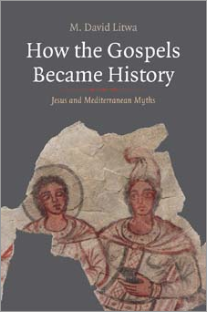 We arrive now at a point where I am beginning to find more agreement with, and renewed interest in, M. David Litwa’s thesis in How the Gospels Became History.
We arrive now at a point where I am beginning to find more agreement with, and renewed interest in, M. David Litwa’s thesis in How the Gospels Became History.
Having dismissed Dennis MacDonald’s proposal that the gospels (in particular Gospel of Mark) were created intertextually with not only various Jewish books but also Greco-Roman ones (in particular Homer’s epics) Litwa sets forth his view of how non-Jewish ideas found their way into the gospels. The gospel authors (“evangelists”) were necessarily part of a late first-century CE Mediterranean culture that was infused with mythoi (myths). (See the first post of this series for Litwa’s discussion of how these were defined in ancient times.) (Again, all bolded highlighting is mine.)
Greek mythoi were the mass media when the gospels were written in the late first century CE. Mythoi were reflected in virtually all the cultural venues available: sculpture, painting, pantomime, hymn, novels, coins, gems, mosaics, plays, athletic events — even executions. (p. 50)
Litwa expands on this idea,
. . . . What united learned peoples in the provinces was a shared educational system and repertoire of stories, poems, and speeches that virtually every person of culture knew. . . .
Since gospel stories arose when Greek mythoi were the dominant cultural lore, it is not strange to think that this lore shaped the formation of Jesus narratives. . . .
Greek mythology was part of the “pre-understanding” of all those who lived in Hellenistic culture — including Jews and Christians. . . .
. . . As a result of socialization, human beings come to share assumptions that allow’ them to communicate and experience phenomena in a basically similar way.
In this sense, early Jews and Christians were inevitably influenced by the dominant cultural lore. Greek mythic discourses were part of the mainstream, urban culture to which most early Christians belonged. If Christians were socialized in predominantly Greek cultural environments, it is no surprise that they were shaped by the dominant stories. Some of the influence would have been consciously experienced through the educational system. Other influences would have been absorbed by attending plays, viewing works of art, hearing poetry, and simply conversing on a daily basis with Hellenized peoples in the many marketplaces of ideas. (pp. 51-52)
Litwa from there proceeds to a discussion of “gospel genre”.
. . . there is a rough consensus that the gospels best approximate ancient biographical (or bios) literature. We can define biography as a form of historiography focusing on the life and character of a single person. (p. 53)
That sounds simple enough — until we do a little bit of reading of the literature on ancient historiography. I have posted on this topic often enough and part of the reason is that I keep learning new things as I read more. At this point I have to say that some classicists flatly deny that ancient historiography conforms to any clear rules of a single genre. A fuller discussion (again) will have to wait. Till then I will allow Litwa to speak, Continue reading “Review, part 3b (The Thesis) : How the Gospels Became History / Litwa”
